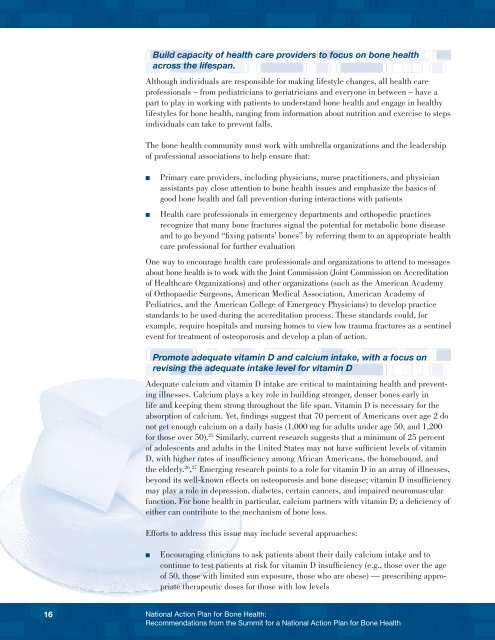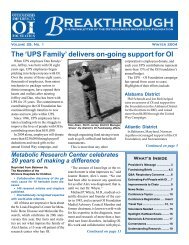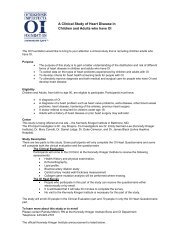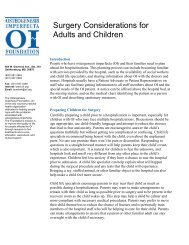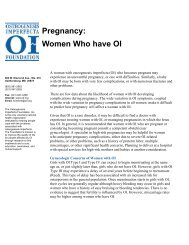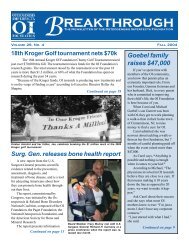National Action Plan for Bone Health - Osteogenesis Imperfecta ...
National Action Plan for Bone Health - Osteogenesis Imperfecta ...
National Action Plan for Bone Health - Osteogenesis Imperfecta ...
You also want an ePaper? Increase the reach of your titles
YUMPU automatically turns print PDFs into web optimized ePapers that Google loves.
Build capacity of health care providers to focus on bone health<br />
across the lifespan.<br />
Although individuals are responsible <strong>for</strong> making lifestyle changes, all health care<br />
professionals – from pediatricians to geriatricians and everyone in between – have a<br />
part to play in working with patients to understand bone health and engage in healthy<br />
lifestyles <strong>for</strong> bone health, ranging from in<strong>for</strong>mation about nutrition and exercise to steps<br />
individuals can take to prevent falls.<br />
The bone health community must work with umbrella organizations and the leadership<br />
of professional associations to help ensure that:<br />
n<br />
n<br />
Primary care providers, including physicians, nurse practitioners, and physician<br />
assistants pay close attention to bone health issues and emphasize the basics of<br />
good bone health and fall prevention during interactions with patients<br />
<strong>Health</strong> care professionals in emergency departments and orthopedic practices<br />
recognize that many bone fractures signal the potential <strong>for</strong> metabolic bone disease<br />
and to go beyond “fixing patients’ bones” by referring them to an appropriate health<br />
care professional <strong>for</strong> further evaluation<br />
One way to encourage health care professionals and organizations to attend to messages<br />
about bone health is to work with the Joint Commission (Joint Commission on Accreditation<br />
of <strong>Health</strong>care Organizations) and other organizations (such as the American Academy<br />
of Orthopaedic Surgeons, American Medical Association, American Academy of<br />
Pediatrics, and the American College of Emergency Physicians) to develop practice<br />
standards to be used during the accreditation process. These standards could, <strong>for</strong><br />
example, require hospitals and nursing homes to view low trauma fractures as a sentinel<br />
event <strong>for</strong> treatment of osteoporosis and develop a plan of action.<br />
Promote adequate vitamin D and calcium intake, with a focus on<br />
revising the adequate intake level <strong>for</strong> vitamin D<br />
Adequate calcium and vitamin D intake are critical to maintaining health and preventing<br />
illnesses. Calcium plays a key role in building stronger, denser bones early in<br />
life and keeping them strong throughout the life span. Vitamin D is necessary <strong>for</strong> the<br />
absorption of calcium. Yet, findings suggest that 70 percent of Americans over age 2 do<br />
not get enough calcium on a daily basis (1,000 mg <strong>for</strong> adults under age 50, and 1,200<br />
<strong>for</strong> those over 50). 25 Similarly, current research suggests that a minimum of 25 percent<br />
of adolescents and adults in the United States may not have sufficient levels of vitamin<br />
D, with higher rates of insufficiency among African Americans, the homebound, and<br />
the elderly. 26 , 27 Emerging research points to a role <strong>for</strong> vitamin D in an array of illnesses,<br />
beyond its well-known effects on osteoporosis and bone disease; vitamin D insufficiency<br />
may play a role in depression, diabetes, certain cancers, and impaired neuromuscular<br />
function. For bone health in particular, calcium partners with vitamin D; a deficiency of<br />
either can contribute to the mechanism of bone loss.<br />
Ef<strong>for</strong>ts to address this issue may include several approaches:<br />
n<br />
Encouraging clinicians to ask patients about their daily calcium intake and to<br />
continue to test patients at risk <strong>for</strong> vitamin D insufficiency (e.g., those over the age<br />
of 50, those with limited sun exposure, those who are obese) — prescribing appropriate<br />
therapeutic doses <strong>for</strong> those with low levels<br />
16 <strong>National</strong> <strong>Action</strong> <strong>Plan</strong> <strong>for</strong> <strong>Bone</strong> <strong>Health</strong>:<br />
Recommendations from the Summit <strong>for</strong> a <strong>National</strong> <strong>Action</strong> <strong>Plan</strong> <strong>for</strong> <strong>Bone</strong> <strong>Health</strong>


